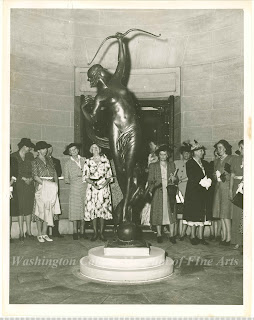Blog
post by: Lauren Ippolito
Assistant Collections
and Exhibitions Manager
Prior
to the commencement of the WCMFA collections inventory project, object
photographs were not consistent in size, format, or quality. Many objects in
the museum’s collection did not have photographs in their object files, and an
even larger number of objects lacked an image on the museum’s database. Every
day of the inventory, we are taking several steps to eliminate this problem. In
addition to taking a high quality digital image of each object, the inventory
team uploads these images onto our PastPerfect database, and prints out an
inventory form that includes a photo for each object file.
An
object’s photograph is of value to the museum staff when responding to
inquiries; preparing educational and interpretive programs and materials;
facilitating outgoing loans to other institutions; and answering requests for
reproductions for scholarly publications.
As
we inventory each object, there are several detail photographs that we will
take if they are present on an object. We note the artist’s signature, any
makers’ mark, or hallmark on an object in the PastPerfect database and take a
close-up photo. The painting below titled Moonlight by Emil Carlsen (American,
1853-1932) illustrates how it can be difficult to identify a signature in a photograph
of the entire object.
The
signature, as shown below, happens to be in the lower proper right corner of
the painting.
If
an object is framed, the inventory team photographs the object and its frame.
The visual documentation of the frame assists staff when identifying objects,
in planning and designing exhibitions, and for condition records. The inventory
team also takes a photograph that we usually crop in order to have an image of
only the object. The example below is Steer in Pasture by Henry Singlewood Bisbing (American,
1849-1933).
The
inventory team photographs any labels or inscriptions on the frame. The
following image shows the Lewis & Son Artistic Picture Frames’ label found
on the back of a painting’s frame.
To
supplement our condition reports of each object, the inventory team takes
close-up photographs of specific condition issues. The photograph below shows a
detail of a painting with crackled paint.
Every
now and then, the inventory team finds something unique that we will
photograph. For example, one of the WCMFA’s paintings by American artist, Charles
Hugo Walther (1879-1938), Back Porch, 1928, has a still life sketch on the back of the canvas board
that the painting is on.
Many
of the images that we are uploading to the PastPerfect database will be
available on our future online component of our PastPerfect database, which
will allow the museum to share images of its collection with a larger audience
than ever before.












